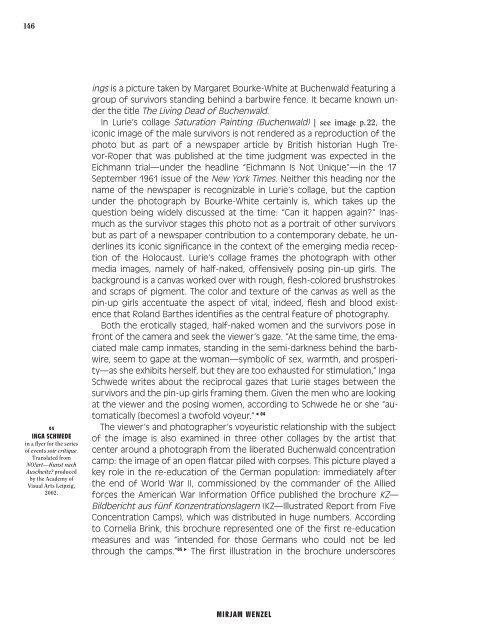The Art of
Katalog_Boris-Lurie_English
Katalog_Boris-Lurie_English
You also want an ePaper? Increase the reach of your titles
YUMPU automatically turns print PDFs into web optimized ePapers that Google loves.
146<br />
04<br />
INGA SCHWEDE<br />
in a flyer for the series<br />
<strong>of</strong> events soir critique.<br />
Translated from<br />
NO!art—Kunst nach<br />
Auschwitz? produced<br />
by the Academy <strong>of</strong><br />
Visual <strong>Art</strong>s Leipzig,<br />
2002.<br />
ings is a picture taken by Margaret Bourke-White at Buchenwald featuring a<br />
group <strong>of</strong> survivors standing behind a barbwire fence. It became known under<br />
the title <strong>The</strong> Living Dead <strong>of</strong> Buchenwald.<br />
In Lurie‘s collage Saturation Painting (Buchenwald) | see image p. 22, the<br />
iconic image <strong>of</strong> the male survivors is not rendered as a reproduction <strong>of</strong> the<br />
photo but as part <strong>of</strong> a newspaper article by British historian Hugh Trevor-Roper<br />
that was published at the time judgment was expected in the<br />
Eichmann trial—under the headline “Eichmann Is Not Unique”—in the 17<br />
September 1961 issue <strong>of</strong> the New York Times. Neither this heading nor the<br />
name <strong>of</strong> the newspaper is recognizable in Lurie‘s collage, but the caption<br />
under the photograph by Bourke-White certainly is, which takes up the<br />
question being widely discussed at the time: “Can it happen again?” Inasmuch<br />
as the survivor stages this photo not as a portrait <strong>of</strong> other survivors<br />
but as part <strong>of</strong> a newspaper contribution to a contemporary debate, he underlines<br />
its iconic significance in the context <strong>of</strong> the emerging media reception<br />
<strong>of</strong> the Holocaust. Lurie‘s collage frames the photograph with other<br />
media images, namely <strong>of</strong> half-naked, <strong>of</strong>fensively posing pin-up girls. <strong>The</strong><br />
background is a canvas worked over with rough, flesh-colored brushstrokes<br />
and scraps <strong>of</strong> pigment. <strong>The</strong> color and texture <strong>of</strong> the canvas as well as the<br />
pin-up girls accentuate the aspect <strong>of</strong> vital, indeed, flesh and blood existence<br />
that Roland Barthes identifies as the central feature <strong>of</strong> photography.<br />
Both the erotically staged, half-naked women and the survivors pose in<br />
front <strong>of</strong> the camera and seek the viewer‘s gaze. “At the same time, the emaciated<br />
male camp inmates, standing in the semi-darkness behind the barbwire,<br />
seem to gape at the woman—symbolic <strong>of</strong> sex, warmth, and prosperity—as<br />
she exhibits herself, but they are too exhausted for stimulation,” Inga<br />
Schwede writes about the reciprocal gazes that Lurie stages between the<br />
survivors and the pin-up girls framing them. Given the men who are looking<br />
at the viewer and the posing women, according to Schwede he or she “automatically<br />
[becomes] a tw<strong>of</strong>old voyeur.” 04<br />
<strong>The</strong> viewer‘s and photographer‘s voyeuristic relationship with the subject<br />
<strong>of</strong> the image is also examined in three other collages by the artist that<br />
center around a photograph from the liberated Buchenwald concentration<br />
camp: the image <strong>of</strong> an open flatcar piled with corpses. This picture played a<br />
key role in the re-education <strong>of</strong> the German population: immediately after<br />
the end <strong>of</strong> World War II, commissioned by the commander <strong>of</strong> the Allied<br />
forces the American War Information Office published the brochure KZ—<br />
Bildbericht aus fünf Konzentrationslagern (KZ—Illustrated Report from Five<br />
Concentration Camps), which was distributed in huge numbers. According<br />
to Cornelia Brink, this brochure represented one <strong>of</strong> the first re-education<br />
measures and was “intended for those Germans who could not be led<br />
through the camps.” 05 <strong>The</strong> first illustration in the brochure underscores<br />
MIRJAM WENZEL



